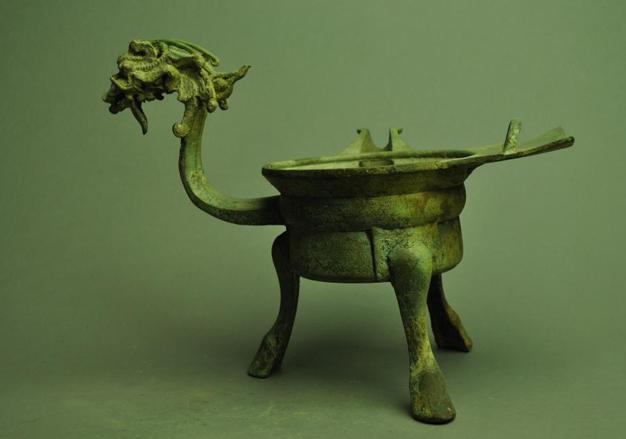Irons
Irons were called in ancient China “yundou”, “huodou” and “jindou”. Ancient Bronzes in the Collection of Zhensong Hall (Vol. XV) describes an iron of the Han Dynasty. This article inscribed with the term “iron (yundou)” has a long handle, flat bottom and swallow foot. The iron could be loaded with burning charcoal. One used it to iron clothes by holding the handle.
An iron has a handle, but no foot. It is usually flat bottomed. Xu Jiazhen made a detailed investigation into ancient irons [10] in Irons, Jiaodou and Diaodou. There are two types of irons in ancient China:
One type is round in shape and has a lid on it. The lid with holes is removable for loading charcoal. The iron of the Taihe era of the Northern Wei Dynasty illustrated on p.1 and p.2 in Vol. XXII of Liangleixuan Yiqi Tushi (Wu Yun’s Annotated Catalog of Sacrificial Vessels) by Wu Yun is of this type. (Fig.11)
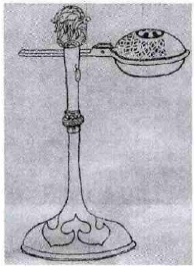
Fig.11 An iron of the Taihe era, Northern Wei Dynasty
The other type features a round belly and open mouth and is lidless. Irons of this type are widely described in various works and opinions on the type vary greatly. The iron of the first year of the Zhengshi era in the collection of Henan Museum (Fig.12) has a round shallow belly, flared mouth, broad rim and slightly-circular bottom. The semi-cylindrical long handle is inscribed with a line of 23 characters. The article is entirely plain.
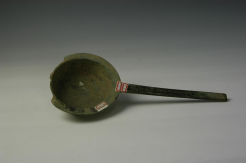
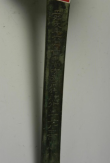
Fig.12 An iron of the first year of the Zhengshi era
There is in the collection of the Museum of Fine Arts Boston the Song Dynasty copy of the painting Court Ladies Preparing Newly Woven Silk originally drawn by Zhang Xuan of the Tang Dynasty. The lady in the center holds the middle part of the silk with her left hand and irons it with an iron in her right hand. (Fig.13) The iron that lady is using is also with a long handle, flat-bottomed and legless.
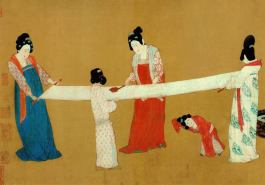
Fig.13 Song Dynasty copy of the painting Court Ladies Preparing Newly Woven Silk originally drawn by Zhang Xuan of the Tang Dynasty (part)
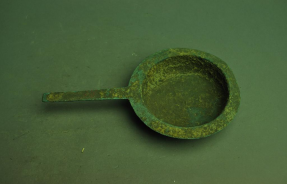
Another iron of the Han Dynasty in the collection of Henan Museum looks like a spoon with a semi-cylindrical handle, folded rim and flat-bottomed. The article used to be thought as a jiaodou vessel or a musical instrument. There is such an iron in the collection of the Palace Museum in Beijing, with the inscription of “iron” on it.
Are jiaodou and diaodou the same vessel? What do you think?
Your answer please, if you have any questions or answer, please feel free to send us email, we are waiting for your answers and participation, and your comments, answers and suggestions will be highly appreciated. We will select and publicize the most appropriate answers and comments some time in the future.
Weekly Selection Email: meizhouyipin@chnmus.net
Jiaodou vessels are often confused with diaodou vessels in historical documents and monographs.
Pei Yin of the Song Dynasty quoted in his Ji Jie (Collected Annotations) Meng Kang’s words: “A bronze jiao is one dou in capacity. It is used as a cooker in daytime and struck for warning signals at night, thus known as daodou.” Guang Yun (A General Book of Rhymes) of the Northern Song Dynasty explains jiao(dou) as diaodou. Such confusions are commonly seen in the books of the Qing Dynasty in particular. Irons were called “diaodou” in Liangleixuan Yiqi Tushi (Wu Yun’s Annotated Catalog of Sacrificial Vessels): “The diaodou (in the right) is decorated with fish and Huoquan-coin patterns, with a small seal in the center, reading ‘For many sons and grandsons’.” In Han Jinwen Lu (Catalog of the Inscriptions on the Han Bronzes), the iron with the Huoquan-coin pattern was called “qiaodou”. Thus, jiaodou vessels would in later generations be confused with diaodou. In actuality, jiaodou and diaodou are two different articles.
Jiaodou vessels have been found in many different places across China and survived today in large numbers. The discovered ones date from various periods from the Han to Tang and Song dynasties, mostly made of bronze and porcelain. They have different features as dynasties vary. The bronze jiaodou vessel (Fig.5) of the Han Dynasty measures 10.70cm wide in inner diameter and 13.00cm in height. The handle is 24.70cm long. It features a round deep belly and the rim of mouth slightly turns upward with a spout. At the end of each triangular prism-shaped leg there is a horse hoof-shaped foot. The long handle is rectangular in section and features a round shovel-like end. The rim is slightly damaged.
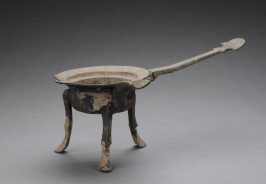
Fig.5
The jiaodou vessel (Fig.6) of the Western Jin Dynasty measures 25.00cm in overall length and 15.00cm wide in diameter at the mouth. The basin-shaped vessel features a flared mouth with rim. The round belly has a slightly-circular bottom with three hoof-shaped feet. The curved handle on the belly has a dragon head-shaped end. The damaged part on the rim is about 5.5cm long.
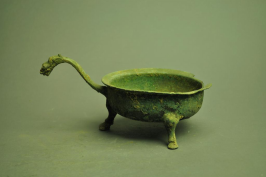
Fig.6
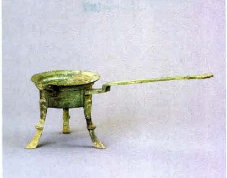
Fig.7 Copper jiaodou vessel, the seventh year of the Yongming era of Qi, Southern Dynasties
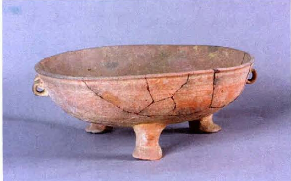
Fig.8 Three-legged pottery fire pan, the seventh year of the Yongming era of Qi, Southern Dynasties
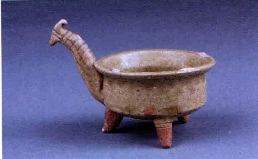
Fig.9 Celadon jiaodou vessel, Tang Dynasty
Jiaodou vessels have been often found in the tombs of the Southern and Northern Dynasties, such as a copper jiaodou vessel of the seventh year of the Yongming era of Qi of the Southern Dynasties that was unearthed together with a fire pan (Fig.7 and Fig.8) [7]. Jiaodou vessels have been often found in the tombs of the Tang Dynasty as well. A celadon jiaodou vessel (Fig.9) was unearthed in 1975 from the Tang tomb at Fuzhou Nursing School. This vessel looks crude with no glaze on its three pottery legs. The dragon head on the handle is simplified. The vessel is smaller than those from the Southern and Northern Dynasties. It measures about 8cm wide in diameter at the mouth and only 8.4cm in overall height.
In historical documents, “diaodou” is usually confused with “jiaodou”. Nonetheless, there are differences between the two, as indicated in documentation and archaeological data.
“Diaodou” or alternatively “daodou” emerged earlier than “jiaodou” in historical documents in existence. The term was first seen in Sima Qian’s the Records of the Grand Historian: Biography of General Li Guang: “Cheng Bushi and Li Guang were both military governors on borders. When Li Guang led his troops to launch an attack on the Huns, he didn’t marshal soldiers in rank for battle. Instead, they chose anywhere with plenty of water and lush grass to get stationed and Li’s men didn’t need to keep night watch by striking daodou at the encampment.” The Book of Han: Traditions of the Western Regions-Kophen also includes records about diaodou: “100-plus soldiers were sent (by the Han court) to keep watch there by striking daodou at night to send warning signals. However, the Han regions couldn’t be spared from harasses.” As implied in the above quotations, diaodou was used to send warning signals in the army in ancient times.
Diaodou’s use in the army was also described in poems after the Han Dynasty. It is used as a symbol of army life in poems of the Southern and Northern Dynasties and in those of the Tang Dynasty, such as A Poem to General Huo’s Northern Expedition by Yu Xi of Liang of the Southern Dynasties, A Ballad of Yan by Gao Shi, A Ballad of Soldiers by Li Qi and In the Moonlight of 15th August by Du Fu. “Diaodou” in historical documents is mostly related to military affairs. Thus, diaodou was used to send warning signals in the army in ancient times. Nonetheless, there are no detailed descriptions about the shape of diaodou in any historical documents.
According to Vol. XXI of Zhaoming Wenxuan (Literary Works Selected by Xiao Tong) of Liang of the Southern Dynasties, the Book of Han said that Li Guang didn’t marshal soldiers in rank for battle and his men didn’t need to keep night watch by striking diaodou. Meng Kang said, “A bronze jiao is one dou in capacity. It is used as a cooker in daytime and struck for warning signals at night, thus known as diaodou. The item is now in the armory in Xingyang.”
Meng Kang lived in State Wei during the Three Kingdoms Period. As implied by his writing of “The item is now in the armory in Xingyang”, he may see diaodou personally. “A bronze jiao” in Meng’s description may be a category title that is the same as “the jiao vessel” in Kangxi Dictionary of the Qing Dynasty. Jiaodou and diaodou both belong to this category. But they are different things in essence.
In addition, jiaodou and diaodou are also different in capacity. According to historical documents, both jiaodou and diaodou are of one dou in capacity. Nevertheless, unearthed jiaodou vessels vary in size and capacity. There was never a unified standard for the vessel’s size in history. Thus, jiaodou was never used as a standard measuring vessel. Instead, jiaodou vessels were only articles for daily use. Meng Kang’s “A bronze jiao is one dou in capacity” didn’t go with the actual situation.
Diaodou was long in use in the army. Army provisions were placed under strict management in ancient times. “Used as a cooker in daytime and struck for warning signals at night”, diaodou must have been well regulated for its shape and size. Soldiers in the pre-Qin period cooked for themselves. For example, the Qi army set up “100,000 stoves” after having entered State Wei. They then reduced their stoves to 50,000 and later further to 30,000. In consideration of the cooking practice in the army, Meng Kang’s description of “A bronze jiao is one dou in capacity” fit better for diaodou, instead of jiaodou. No vessels inscribed with “diaodou” have been discovered so far, perhaps because diaodou was an article for daily use in the army.
Moreover, jiaodou vessels that have been discovered by now are mostly small in size. Such a vessel has three legs and one long handle that is usually a curved one, thus not convenient to be held for striking. This doesn’t go with Meng Kang’s description of the vessel “used as a cooker in daytime and struck for warning signals at night”. Jiaodou vessels in existence also vary greatly in craftsmanship, some crudely made and others of delicate workmanship. This may depend upon the owner’s status and life style.
In summary, jiaodou and diaodou are actually two different things. Renowned archaeologist Sun Ji differentiated jiaodou from diaodou in his Illustrated Explanations of the Material Culture of the Han Dynasty. According to Sun, jiaodou and diaodou are different vessels and diaodou is a legless cauldron-shaped cooking vessel with handle. However, Sun’s assumption needs more archaeological evidence.
As Shuo Wen Jie Zi (Analytical Dictionary of Characters) puts it, “Jiao refers to a jiaodou vessel”. As is quoted in Volume I of Xuanying Yin Yi (Xuanying’s Transliterations and Meanings) from Yun Ji (Rhymes), “Jiao is a warmer with handle and three legs”. The images of Jiaodou vessels were both recorded in historical documents and found in archaeological discoveries.
The first written records of jiaodou vessels were seen in the Han Dynasty in Chapter III of Shi You’s Ji Jiu Pian (A Quick Learning Program) as “Duan (forged articles), Zhu (cast articles), Qian (lead wares), Xi (tin wares), Deng (a food container), Ding (a steamer), Jiao (jiaodou vessel)”. As Yan Shigu of the Tang Dynasty annotated, “Jiao refers to a jiaodou vessel. It is a warmer looking like a rimless diao vessel (a small cooking pan with handle and spout).” More written records of jiaodou vessels were found from the Han Dynasty. For example, Shi Yuanying (a.k.a. Shi Xuanying) of the Tang Dynasty quoted in Volume XV of Yiqiejing Yin Yi (Transliterations and Meanings of the Tripitaka, a.k.a. Xuanying Yin Yi [Xuanying’s Transliterations and Meanings] from Yun Ji (Rhymes), “Qiao (jiao) is a warmer with handle and three legs”.
Duanfang of the late Qing Dynasty described in Volume VI of his Taozhai Jijin Lu (Duanfang’s Catalog of Ancient Bronzes) a jiaodou vessel of the Han Dynasty. As described by Duanfang, the jiaodou vessel features a round belly, a rimmed mouth, a curved handle and three pointed legs. The inscription on the vessel reads, “Zhongshangfang Administration made a jiaodou vessel on the 14th of the sixth month in the second year of the Jianshi era (31BC). The vessel measures two jin and nine liang in weight and one dou in capacity.” (Fig.3) Also in this catalog there is another jiaodou vessel with a wild duck head of the Han Dynasty (Fig.4). “Zhongshangfang” was an administration in charge of craftwork in the Han Dynasty. Thus, the jiaodou vessel was a piece made in the government-run workshops. The term “jiaodou” in the inscription tallies with the historical records of the Han Dynasty in terms of the time of jiaodou vessels. It is a piece of solid physical evidence to the historical date of jiaodou vessels.
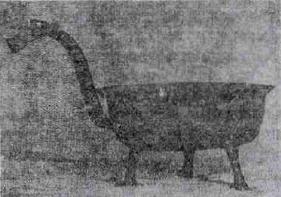
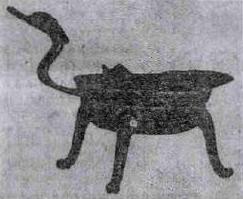
It’s been commonly accepted that jiaodou vessels evolved from jiaohu pots. While a jiaohu pot has a lid, a jiaodou vessel is usually lidless and features a belly, a spout, three legs and a straight or curved handle. The jiaodou vessels found by now are mostly bronze ones. There are iron and pottery ones as well. According to the archaeological discoveries and excavations after 1949, jiaodou vessels have been found in different areas across China. In addition to the Central Plains, they’ve been also unearthed in remote areas like Inner Mongolia, Yunnan and Gansu provinces in a large number. Mr.Wu Xiaoping made an analysis of bronze jiaodou vessels in existence and identified development stages in accordance with the evolvement of the vessel shape. According to Mr.Wu, jiaodou vessels first emerged in the Han Dynasty, reached the peak during the Six Dynasties and declined from the Tang Dynasty [1]. Bronze jiaodou vessels became rare from the Song Dynasty.
Jiaodou vessels in early days were quite simple in shape. They gained popularity during the Southern and Northern Dynasties. The examples unearthed from the tombs of the time feature complicated shapes, delicate craftsmanship and curved handles in most cases, and their handles are in the shape of lifelike dragon heads.
Opinions vary about the use of a jiaodou vessel. Xuanhe Bogu Tu (Antique Catalog of the Xuanhe Era) of the Northern Song Dynasty described a bronze jiaodou vessel in the collection of the Xuanhe Hall: “The vessel (in the right) measures seven cun and eight fen in height, two cun and three fen in depth, four cun and three fen wide in diameter at the mouth, one liter in capacity and three jin and one liang in weight, with ear, spout and handle, but without inscription. It is a jiaodou vessel. According to Xu Shen, dou (literally “a dipper”) in the name implies that the vessel is used as a warmer.” Many bronze jiaodou vessels discovered by now have visible traces of soot on the bottom or feet. Such trace is seen on the bottom of the bronze jiaodou vessel of the Western Jin Dynasty unearthed from the Xincheng Township, Dayu County, Jiangxi Province.
In addition, a jiaodou vessel is usually placed together with a three-legged pottery fire pan in a tomb, as shown by archaeological discoveries. Thus, the academic circles have agreed that jiaodou vessels were used to heat or warm things.
Jiaodou vessels were widely used for different purposes later, thanks to their special shape. They have often been unearthed together with articles for daily use, such as pots, basins and cups. Also, jiaodou vessels vary a lot in design and decoration, as tomb occupants’ social status differed. Therefore, the academic circles have also suggested that jiaodou vessels be used to warm wine or prepare tea.
The bronze jiaodou vessel with a dragon head and a phoenix tail features a round belly. The end of the curved handle is made into a dragon head, its eyes popping out and its mouth slightly open. There are palpi on its chin. Its horns bend backward into a pair of arched perforations. The long handle is welded to the vessel’s belly.
There is a U-shaped spout on one side of the flared rim of mouth. String pattern goes around the lower part of the plain straight belly that features a flat bottom. The vessel has a phoenix tail at the rear, slightly turning upward, on which there is a semi-circular loop handle (Fig.1). The three hoof-shaped legs all flare out and are inscribed with characters “Li”, “Bao” and “Ji”, respectively. (Fig.2)
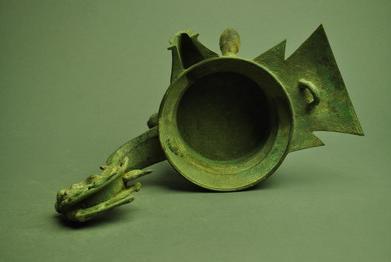
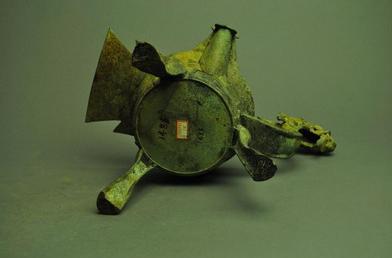
Well preserved, fully covered by patina, and with obvious traces of soot on its belly and bottom, the bronze jiaodou vessel looks elegant in shape and features superb craftsmanship, is a rare treasure of the category in the Song Dynasty.
